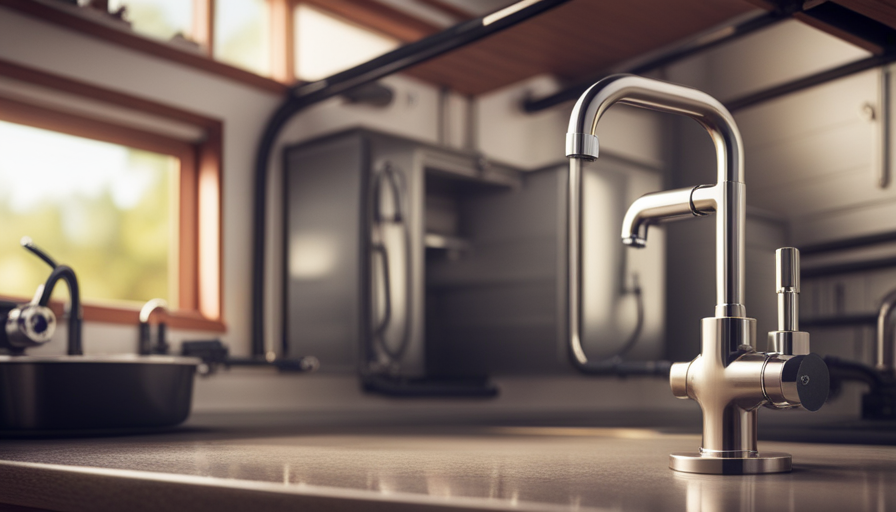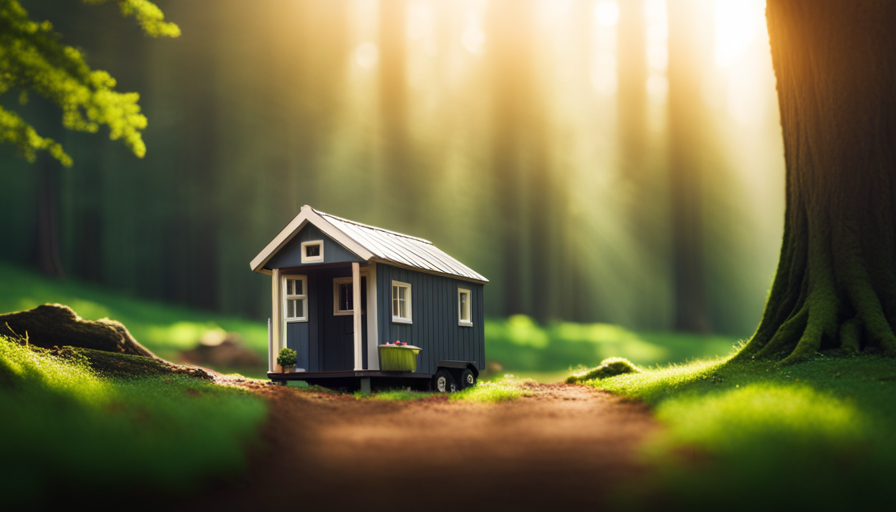Are you experiencing problems with an unwelcome visitor in your home? Those tiny, annoying insects that appear out of nowhere and fly around your living area? Indeed, I’m talking about gnats.
These minuscule insects can quickly become a nuisance, but fear not, for I am here to guide you through the art of gnat elimination. As a seasoned entomologist, I have delved deep into the world of these bothersome pests, studying their behavior and life cycle. With my expertise, I will provide you with accurate and reliable information, ensuring no detail is overlooked.
From identifying their source to implementing effective control methods, I will walk you through the step-by-step process of banishing these tiny intruders from your humble abode. So, let’s dive into the world of gnats and learn how to reclaim your home from their clutches.
Key Takeaways
- Inspect indoor plants for signs of gnats or larvae and remove them.
- Keep the kitchen clean by regularly cleaning and removing fallen fruits or vegetables, emptying and cleaning garbage cans, and wiping down countertops and tables.
- Use sticky traps, vinegar traps, fly swatters, or insecticide sprays to catch or eliminate gnats.
- Practice proper odor control and use odor-absorbing materials in trash bins.
Identify the Source of the Gnats
To get rid of those pesky gnats in your house, you need to identify where they’re coming from. Gnats are small, flying insects that belong to the family of flies. They are commonly found in homes and can be a nuisance to deal with.
As an entomologist, I understand the behavior and life cycle of gnats, which allows me to provide accurate and reliable information about their potential infestation in a house.
Gnats are attracted to potential breeding grounds, such as moist areas and decaying organic matter. One common breeding ground for gnats is indoor plants. Their larvae thrive in the damp soil and feed on decaying plant matter. To identify if your plants are the source, inspect the soil for any signs of gnats or their larvae. Look for tiny, worm-like creatures that are white or translucent.
Additionally, another potential breeding ground for gnats is overripe fruits and vegetables. As these items start to decay, they emit a scent that attracts gnats. By removing overripe fruits and vegetables from your kitchen, you can eliminate a major food source for the gnats. This step is crucial in breaking the gnat life cycle and preventing further infestation.
By identifying the potential breeding grounds and taking necessary actions like inspecting indoor plants and removing overripe fruits and vegetables, you can effectively reduce the gnat population in your house.
Remove Overripe Fruits and Vegetables
Eliminate the pesky little bugs by disposing of any overripe fruits and vegetables in your home. Gnats are attracted to the sweet smell of decaying produce, so removing these food sources is crucial in preventing them from entering your house.
Here are three ways to prevent gnats from entering your home and to store fruits and vegetables to avoid attracting them:
-
Store fruits and vegetables in airtight containers or in the refrigerator. Gnats are attracted to the smell of ripening fruits, so sealing them off will help keep them away.
-
Clean your kitchen regularly and promptly remove any fallen fruits or vegetables. Also, check for any hidden rotting produce in your pantry or other storage areas.
-
Empty and clean your garbage cans regularly. Gnats are also attracted to organic matter and can breed in the damp environment of a trash bin.
By following these practices, you can significantly reduce the chances of a gnat infestation in your home. Once you have dealt with the source of the gnats, it’s important to address other potential breeding grounds. Transitioning into the next section, cleaning up spills and food crumbs will help eliminate additional attractants for gnats.
Clean Up Spills and Food Crumbs
Clearing up spills and food crumbs is like sweeping away the breadcrumbs that lead gnats straight to your home. Gnats are attracted to the scent of decaying organic matter, and any food particles left behind can serve as a feast for these pesky insects. To prevent future gnat infestations, it’s crucial to clean up spills and food crumbs promptly and effectively.
Start by wiping down countertops and tables with a mixture of vinegar and water. This won’t only remove any food residue but also deter gnats with its strong odor. Pay special attention to hidden areas like under appliances and behind furniture, as gnats can find their way into even the smallest crevices.
Next, vacuum your floors and carpets thoroughly to eliminate any remaining food crumbs. Empty the vacuum bag or canister outside to ensure that gnats aren’t reintroduced into your home. For hard-to-reach areas, use a crevice tool to dislodge any trapped debris.
Remember to also clean up spills immediately. Even the tiniest droplet can attract gnats, so use a damp cloth or paper towel to wipe away any liquid. For sticky spills, like juice or syrup, mix equal parts of water and dish soap to break down the residue effectively.
By cleaning up spills and food crumbs diligently, you can significantly reduce the chances of a gnat infestation in your home. However, it’s equally important to keep trash bins sealed tightly to prevent gnats from breeding and multiplying.
Keep Trash Bins Sealed
Keeping trash bins tightly sealed is essential in preventing gnat infestations in your home. Gnats are attracted to the smell of decaying organic matter, and trash bins provide a perfect breeding ground for these tiny pests. To effectively control gnats, it is important to focus on odor control in trash bins and pest-proofing kitchen storage areas.
To understand the significance of sealing trash bins, let’s take a closer look at gnats’ behavior and breeding habits. Gnats, also known as fruit flies, are attracted to the scent of rotting food and organic waste. By keeping trash bins tightly sealed, you eliminate their access to these attractive odors, making your home less appealing to them.
In addition to sealing trash bins, it is crucial to practice proper odor control. Regularly emptying and cleaning the bins will help prevent the buildup of odorous substances that attract gnats. Consider using odor-absorbing materials such as baking soda or deodorizer packets to further minimize the attractiveness of your trash bins.
Furthermore, pest-proofing kitchen storage areas is another effective measure to keep gnats at bay. Ensure that all food items are properly stored in airtight containers, minimizing the chances of gnats finding a food source in your kitchen. Regularly clean and inspect cabinets, pantries, and other storage areas to eliminate any potential breeding grounds.
By implementing these measures, you can significantly reduce the likelihood of gnat infestations in your home. In the next section, we will explore another step to tackle these tiny pests: using sticky traps to catch gnats.
Use Sticky Traps to Catch Gnats
Try using sticky traps to catch those pesky little fruit flies that always seem to find their way into your home. Did you know that just one sticky trap can catch up to 100 gnats in a week?
Gnats are small insects that are attracted to ripe fruits, vegetables, and decaying organic matter. They can quickly become a nuisance, buzzing around your face and contaminating your food.
To effectively catch these tiny pests, I recommend placing sticky traps near areas where you often see them, such as near windows, fruit bowls, or trash bins. The sticky surface of the traps will attract the gnats and prevent them from flying away.
You can also use fly swatters to manually eliminate gnats in areas where they are concentrated. If the infestation is severe, you may consider using insecticide sprays specifically designed for gnats. However, it’s important to read and follow the instructions carefully to ensure the safety of yourself and your family.
By using sticky traps, fly swatters, or insecticide sprays, you can significantly reduce the gnat population in your home and enjoy a gnat-free environment.
Now, let’s move on to the next step: setting up vinegar traps.
Set Up Vinegar Traps
To effectively combat the presence of gnats in your home, consider utilizing vinegar traps as a proactive measure. Gnats are small, flying insects that are attracted to the scent of vinegar. By setting up vinegar traps, you can effectively lure and capture these pesky creatures.
Here are some key points to keep in mind when using vinegar traps:
- Mix equal parts of apple cider vinegar and water in a small bowl or cup.
- Add a few drops of dish soap to break the surface tension of the liquid.
- Cover the container with plastic wrap and secure it with a rubber band.
- Poke small holes in the plastic wrap to allow the gnats to enter.
Gnats are drawn to the vinegar scent and will enter the trap through the holes. Once inside, they will become trapped in the liquid. Empty and replace the traps regularly to ensure continued effectiveness.
If you’re looking for alternatives to vinegar, you can try using other sweet liquids like fruit juice or wine. These liquids also attract gnats and can be used in a similar manner.
By following these steps, you can effectively reduce the gnat population in your home. Try natural repellents like essential oils to further enhance your gnat control efforts.
Try Natural Repellents like Essential Oils
If you’re tired of those pesky little pests invading your home, why not give natural repellents like essential oils a whirl? Not only do essential oils have a pleasant aroma, but they can also be effective in repelling gnats and other insects. Certain essential oils, such as citronella, peppermint, and lavender, are known for their bug-repelling properties. These oils work by masking the scents that attract gnats and other pests, making your home less appealing to them.
To effectively use essential oils as a gnat repellent, you can create your own DIY spray by mixing a few drops of your chosen oil with water in a spray bottle. Simply spray the mixture in areas where you’ve noticed gnats, such as around windows, doors, and plants. You can also add a few drops of essential oil to cotton balls and place them in gnat-prone areas.
It’s important to note that essential oils should be used with caution, as they can be harmful to pets and children if ingested or applied directly to the skin. Always follow the instructions and dilution ratios recommended by the essential oil manufacturer.
In the next section, we will discuss how ensuring proper drainage in potted plants can help eliminate gnats from your home.
Ensure Proper Drainage in Potted Plants
Having proper drainage in your potted plants can save you from the frustration and annoyance of dealing with those pesky insects. As an entomologist, I understand the behavior and life cycle of gnats, and I can provide you with accurate and reliable information on how to get rid of them.
One important step in preventing gnat infestations is to ensure that water doesn’t stagnate in your potted plants. Gnats are attracted to damp soil, so it’s crucial to have adequate drainage holes in your pots and avoid overwatering. This will help keep the soil dry and discourage gnats from breeding.
In addition to proper drainage, using insecticides specifically designed for potted plants can also be effective in controlling gnats. These insecticides can be applied directly to the soil to kill gnat larvae and prevent further infestation. It’s important to follow the instructions on the product label and use insecticides sparingly to minimize any potential harm to your plants.
By preventing water stagnation and using insecticides in your potted plants, you can significantly reduce the chances of a gnat infestation in your home.
In the next section, I will discuss another important aspect of getting rid of gnats: keeping your home clean and dry.
Keep Your Home Clean and Dry
To ensure proper drainage in potted plants, I discussed the importance of using well-draining soil and not overwatering. Now, let’s move on to the next step in getting rid of those pesky gnats: keeping your home clean and dry.
Gnats are attracted to moisture, so preventing moisture buildup in your house is crucial. One of the main areas to focus on is the drains. Gnats can breed in the organic matter that accumulates in drains, providing a perfect breeding ground for them. Regularly cleaning and maintaining your drains will help eliminate this potential gnat habitat.
To visually represent the ideas, here is a table providing a summary of the key points:
| Preventing moisture buildup | Regularly clean and maintain drains |
|---|---|
| Remove standing water | Use drain cleaners or vinegar solution |
| Fix leaky pipes and faucets | Clear debris from drain traps |
| Use dehumidifiers in damp areas | Regularly flush drains with hot water |
By following these steps and keeping your home clean and dry, you can significantly reduce the chances of a gnat infestation. However, if the problem persists, it may be necessary to seek professional pest control assistance.
Seek Professional Pest Control Assistance if Needed
Consider calling a professional pest control service for assistance when dealing with these persistent pests. Wouldn’t it be nice to finally say goodbye to those annoying little bugs? As an entomologist, I’ve got a deep understanding of gnats, their behavior, and their life cycle. Let me provide you with accurate and reliable info about these tiny insects and their potential infestation in your house.
Here are five important tips to consider when seeking professional help or trying DIY pest control methods:
-
Consult with a licensed pest control specialist who can accurately identify the species of gnats in your home and determine the most effective treatment plan.
-
Conduct a thorough inspection of your house to locate potential breeding grounds, such as damp areas, decaying organic matter, or overwatered plants.
-
Remove any standing water sources, fix leaks, and ensure proper drainage to eliminate attractive breeding sites for gnats.
-
Clean your kitchen thoroughly, especially around sinks and garbage disposal areas, as these are common hotspots for gnat activity.
-
Consider using natural gnat repellents, such as vinegar traps or essential oil sprays, as a DIY approach before seeking professional assistance.
By following these steps and seeking professional help if needed, you can effectively get rid of those pesky gnats and create a gnat-free environment in your home.
Frequently Asked Questions
How do I know if the gnats in my house are actually fruit flies?
To accurately identify whether the insects in your house are gnats or fruit flies, observe their appearance and behavior. Gnats have longer legs and are attracted to decaying organic matter, while fruit flies are drawn to ripe fruits. Proper identification is crucial for effective gnat removal methods.
Can I use vinegar traps outside of my house to prevent gnats from entering?
Using vinegar traps outside as a preventive measure against gnats is not very effective. While vinegar may attract some gnats, it is unlikely to repel them from entering your house.
What are some natural repellents that are safe to use around pets and children?
Natural insecticides and homemade gnat repellents are safe alternatives to use around pets and children. Some effective options include essential oils like lavender or peppermint, apple cider vinegar traps, and sticky fly traps.
Are there any specific essential oils that are more effective in repelling gnats?
The most effective essential oils for repelling gnats include citronella, lemongrass, and peppermint. DIY gnat repellent recipes can be made by combining these oils with water or carrier oils.
How often should I clean my trash bins to prevent gnat infestations?
To effectively prevent gnat infestations, it is crucial to clean trash bins regularly. I recommend cleaning them at least once a week to eliminate potential breeding grounds and minimize the risk of gnat infestations.
Conclusion
In conclusion, getting rid of tiny gnats in your house requires a thorough understanding of their behavior and life cycle. As an entomologist, I’ve provided accurate and reliable information about these pests, offering step-by-step instructions and specific recommendations.
By identifying the source of the gnats, removing overripe fruits and vegetables, cleaning up spills and food crumbs, keeping trash bins sealed, using sticky traps and natural repellents, ensuring proper drainage in potted plants, and maintaining a clean and dry home, you can effectively eliminate these pesky insects.
Remember, even the smallest details matter when it comes to gnat control. So, take action now and bid farewell to these annoying creatures once and for all!
Hi, I’m Emma. I’m the Editor in Chief of Tiny House 43, a blog all about tiny houses. While tree houses are often associated with childhood, they can be the perfect adult retreat. They offer a cozy space to relax and unwind, surrounded by nature. And since they’re typically built on stilts or raised platforms, they offer stunning views that traditional homes simply can’t match. If you’re looking for a unique and romantic getaway, a tree house tiny house might just be the perfect option.










